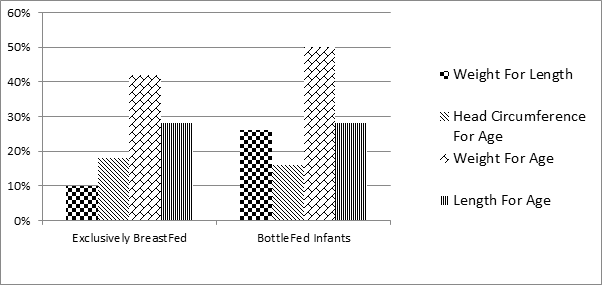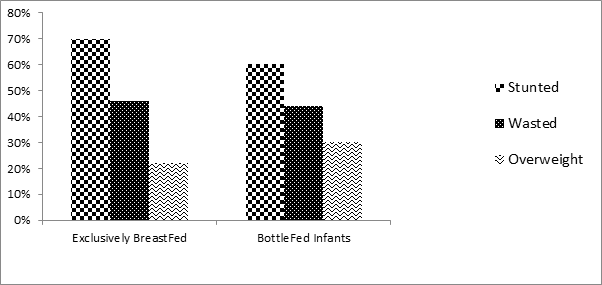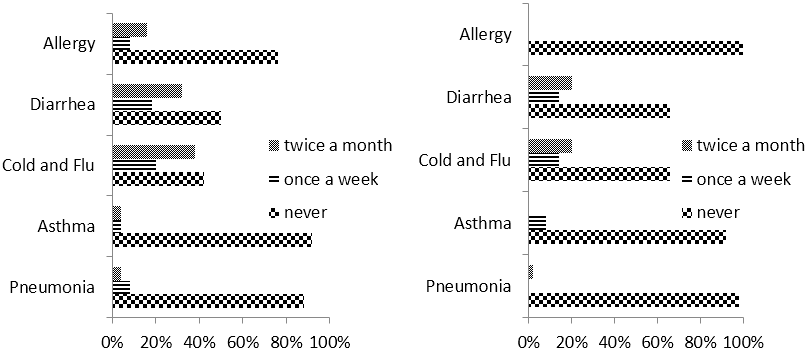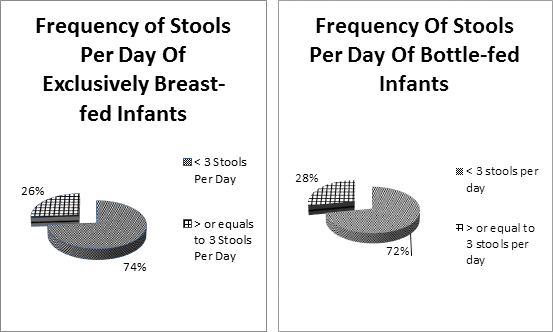Research Article
Volume 1 Issue 4 - 2017
Comparison of Nutritional Status between Exclusively Breastfed and Bottle fed Infants Aged 0-6 Months
RLAK Govt. College of Home Economics, Clinical Dietitian/ Nutritionist, Dr.Ziauddin University Hospital, Clifton Campus, Karachi, Pakistan
*Corresponding Author: Hafiza Syeda Samrina, RLAK Govt. College of Home Economics, Clinical Dietitian/ Nutritionist, Dr.Ziauddin University Hospital, Clifton Campus, Karachi, Pakistan.
Received: August 15, 2017; Published: August 28, 2017
Abstract
Background: Despite the awareness of the advantages of exclusive breast feeding and the disadvantages of bottle feeding, the trend of exclusive breastfeeding has been declining and the trend of bottle feeding is rising.
Objective: To compare the nutritional status between exclusively breast fed and bottle fed infants aged 0-6 months.
Methodology: The subjects of study were 50 infants who were exclusively breast and 50 infants who were bottle fed for the first 6 months. The sample was collected from hospitals all over Karachi. Tool of data collection was a questionnaire that covered different aspects including demographic, anthropometric and overall health. A Chi-square test was applied.
Results: The results revealed that no significant differences were found in the nutritional status of both groups (p > 0.05) as 46% EBF infants were wasted and 70% infants were stunted and 44% were overweight when compared to BF infants i.e. 44% and 60% and 30% respectively. In addition, 18% EBF infants had normal head circumference for age when compared to BOF i.e. 16%. However the incidence of allergies, infection (cold & flu) and diarrhea was significantly (p < 0.05) more prevalent in BOF infants i.e. 8%, 23% and 16% respectively when compared to EBF infants i.e. 0%, 11% and 10% respectively.
Conclusion: There are no significant differences in the nutritional status of exclusively breast fed and bottle fed infants. However, the frequency of infection (cold & flu) and allergy is significantly more prevalent in BOF infants than EBF infants.
Keywords: Exclusive breastfeeding; Bottle feeding; Stunting; Wasting; Diarrhea
Abbreviations: EBF: exclusive breast feeding; BOF: bottle feeding
Introduction
Breastfeeding especially exclusive breastfeeding play a crucial role in child nutrition and development status. Studies have shown that infant weight and height gains during early postnatal life are influenced by infant feeding practices Nutritional problems of children are to a large extent associated with inappropriate feeding practices. This is revealed in a research study that took place in Tanzania where infants were assessed regarding their feeding practices. The study indicated that infants, who received exclusive breast feeding till 4 months, had a good nutritional status as compared to the infants who received non-exclusive breast feeding. Several guidelines have been developed to promote appropriate infant feeding including the optimal duration of exclusive breastfeeding (EBF). The World Health Organization recommends EBF for the first six months of life. This recommendation is based on evidence of the importance of good nutrition in the early months of life and the role it has in achieving good health. The benefits include prevention of disease and infection in childhood childhood3 4 and improved cognitive and motor skills development. Since the bottle feeding practices are getting more prevalent in Pakistan (i.e. 41%) than exclusive breast feeding (i.e. 37.7%). In Pakistan, mothers are aware of the advantages and disadvantages of breast and bottle feeding but a disparity is observed between their perception and practices (Ali., et al. 2011). Due to the rising rates of bottle feeding practices rather than EBF, it is important to bring a change in mothers feeding practices and spread the benefits of EBF to their infants. There are no previous studies done to compare if there are significant differences among the nutritional status of infants who are exclusively breast fed with bottle fed infants. Hence i carried out this study to find out if the nutritional status of exclusively breast fed infants varies with that of bottle fed infants.
Methodology
The data consisted of a purposive sample of 100 infants aged 0-6 months including males. The sample consisted of 50 infants who were exclusively breast fed and 50 bottle fed infants during the first 6 months. Mothers of the infants were interviewed. Tool of data collection was a questionnaire that involved demographic and anthropometric profile and the incidence of infections, allergies and diarrhea. The anthropometric characteristics were analyzed through WHO growth charts. A Chi-square test was applied.
Results
A purposive sample of 100 infants aged 0-6 months was collected. The sample consisted of 50 exclusively breastfed infants and 50 bottle fed infants. Mothers of the infants were interviewed regarding different aspects. Tool of data collection was a questionnaire. The subjects were recruited from different hospitals of Karachi in order to compare the nutritional status of exclusively breast fed infants with the bottle fed infants. The study revealed that majority of the exclusively breast fed infants were stunted i.e. 70% and 46% were wasted when compared to bottle fed infants i.e. 60% and 44% respectively. It was revealed that bottle feeding was associated with good weight for age scores, and exclusive breast feeding was associated with reduced or no prevalence of infection (cold& flu) allergy among infants.
Demographic Characteristics of the Subjects
The sample consisted of 100 infants. Data was collected using a purposive sample technique. Majority of the infants were boys and most infants were 1-2 months old. Majority of their mothers were highly educated and belonged to high income family.
The sample consisted of 100 infants. Data was collected using a purposive sample technique. Majority of the infants were boys and most infants were 1-2 months old. Majority of their mothers were highly educated and belonged to high income family.
| Gender | Frequency/Percentages |
| Boys | 55 |
| Girls | 45 |
| AGE | |
| 0-1 months | 14 |
| 1-2 months | 23 |
| 2-3 months | 20 |
| 3-4 months | 15 |
| 4-5 months | 14 |
| 5-6 months | 14 |
| Mother’s Education Level | |
| Non Educated | 03 |
| < Matriculate | 11 |
| > Matriculate | 18 |
| Graduate | 68 |
| Income Level | |
| > 20000 | 38 |
| > 50000 | 62 |
Table 1: Demographic Characteristics of the Subjects.
Comparison of Anthropometric Characteristics of Exclusively Breast Fed and Bottle Fed Infants
Infant’s weight-for-length, length-for-age, weight-for-length and head circumference-for-age were assessed through WHO growth charts. The results revealed that no significant differences were found in the weight-for-length (p = 0.086), weight-for-age (p = 0.197) and length-for-age (p = 0.138) of both groups. But as far as the head circumference-for-age is concerned, there was a significant difference (p = 0.05) among both groups.
Infant’s weight-for-length, length-for-age, weight-for-length and head circumference-for-age were assessed through WHO growth charts. The results revealed that no significant differences were found in the weight-for-length (p = 0.086), weight-for-age (p = 0.197) and length-for-age (p = 0.138) of both groups. But as far as the head circumference-for-age is concerned, there was a significant difference (p = 0.05) among both groups.
Comparison of Stunting, Wasting and Overweight Among Exclusively Breastfed and Bottle-Fed Infants
Less bottle-fed infants were stunted when compared to exclusively breast-fed infants i.e. 60% and 70% respectively.46% of bottle-fed infants were wasted which was approximately same as exclusively breast-fed infants i.e. 44%. But overall no significant differences were found in stunting (p = 0.138), wasting (p = 0.086) and overweight (p = 0.197) among both groups of infants.
Less bottle-fed infants were stunted when compared to exclusively breast-fed infants i.e. 60% and 70% respectively.46% of bottle-fed infants were wasted which was approximately same as exclusively breast-fed infants i.e. 44%. But overall no significant differences were found in stunting (p = 0.138), wasting (p = 0.086) and overweight (p = 0.197) among both groups of infants.
Figure 2: Comparison of stunting, wasting and overweight exclusively breast-fed and bottle fed infants.
Bottle-Fed Infants Exclusively Breast-Fed Infants
Figure 3: Comparison of the frequency of stools among exclusively breast-fed and bottle fed infants.
Figure 4: Comparison of the frequency of stools among exclusively breast-fed and bottle fed infants.
Frequency of infections, diarrhea and allergy among exclusively breast-fed and bottle fed infants
The results revealed that no significant differences were found in the frequency of asthma (p = 0-264) and pneumonia (p = 0.10) in most of the exclusively breast-fed and bottle-fed infants. But, the frequency of cold and flu was more prevalent in bottle fed infants with a significant difference (p = .05). Also, there were no significant differences (p = 0.254) in the frequency of diarrhea among both groups of infants. In addition, the frequency of allergy was also prevalent in bottle fed infants with a significant difference (p = 0.001).
The results revealed that no significant differences were found in the frequency of asthma (p = 0-264) and pneumonia (p = 0.10) in most of the exclusively breast-fed and bottle-fed infants. But, the frequency of cold and flu was more prevalent in bottle fed infants with a significant difference (p = .05). Also, there were no significant differences (p = 0.254) in the frequency of diarrhea among both groups of infants. In addition, the frequency of allergy was also prevalent in bottle fed infants with a significant difference (p = 0.001).
Frequency of stools among exclusively breast-fed and bottle fed infants
According to the results, diarrhea was more common in BF infants than in EBF infants as it shows that in BF infants 50% reported diarrhea but according to the definition of diarrhea, only 26% infants were suffering from diarrhea. Similarly, 34% EBF infants reported diarrhea but according to the definition of diarrhea, only 24% were actually suffering from diarrhea with no significant difference (p = 0.245).
According to the results, diarrhea was more common in BF infants than in EBF infants as it shows that in BF infants 50% reported diarrhea but according to the definition of diarrhea, only 26% infants were suffering from diarrhea. Similarly, 34% EBF infants reported diarrhea but according to the definition of diarrhea, only 24% were actually suffering from diarrhea with no significant difference (p = 0.245).
Discussion
The study assessed that majority of the exclusively breastfed infants were stunted when compared to bottle fed infants. These results vary from a research that was conducted in Tanzania where EBF was associated with higher scores for height- for- age (John.G., et al. 2013). A possible reason could be the nutritional status of the mothers or the way they feed their infants. Since improper position of the baby at breast can be a major reason for his poor nutritional status.
Conclusion
It was concluded that there are no significant differences between the nutritional status of exclusively breast fed and bottle fed infants. However the incidence of allergy and infection (cold & flu) was prevalent in bottle fed infants. References
- Picciano MF. “The evidence of breastfeeding: nutrient composition of human milk”. Pediatric Clinics of North America 48 (2001): 53-67.
- WHO (2000) Collaborative Study Team on the Role of Breastfeeding on the Prevention of Infant Mortality. Effect of breastfeeding on infant and child mortality due to infectious diseases in less developed countries: a pooled analysis. Lancet 355(9202:) (2000):451-455.
- Mihrshahi S., et al. “Prevalence of exclusive breastfeeding in Bangladesh and its association with diarrhea and acute respiratory infection: results of the Multiple Indicator Cluster Survey 2003”. Journal of Health, Population and Nutrition 25.2 (2003):195-204.
- Hannon PR., et al. “Adolescent mothers’ infants feeding decisions and breastfeeding practices; a qualitative study”. Journal of Adolescent Health 26 (2000): 399-409.
- Sacker A., et al. “Breastfeeding and developmental delay: findings from the millennium cohort study”. Pediatrics 118.3 (2006): 682-689.
- Kramer MS., et al. “Effects of prolonged and exclusive breastfeeding on child behavior and maternal adjustment: evidence from a large, randomized trial”. Pediatrics 121.3 (2008): 435-440.
- Amal Omer Salim., et al. “Whom can I rely on? Mothers’ approaches to support for feeding: An interview study in suburban Dar es Salaam, Tanzania”. Midwifery 23.2 (2007):177-183.
- Nkala TE and Msuya SE. “Prevalence and predictors of exclusive breastfeeding among women in Kigoma region, Western Tanzania: a community based cross-sectional study”. International Breastfeeding Journal 9.6(1) (2011).
- Pakistan Medical Research Council (PMRC). Pakistan National Nutritional Survey 2011. Nutrition Wing, Cabinet Division, Government of Pakistan.
- Grantham-McGregor SM., et al. “Stunting and mental development in children”. Nutrition Research 16. 11-2 (1996): 1821-1828.
- Hacker A and Cass RC. “Prevalence of infant stunting in an urban Kenyan population: comparison to the 1998 Kenyan Health and Demographic Survey and the 2000 CDC growth grids”. Nutrition Research 23.12 (2003):1643-1649.
- Semba RD. “Effect of parental education on child stunting”. Lancet 371 (2008): 1837.
- Cernades JM., et al. “Maternal and perinatal factors influencing the duration of exclusive breastfeeding during the first 6 months of life”. Journal of Human Lactation 19.2 (2003): 136-144.
- United Nation International Children’s Monitory Fund. Global Breast Feeding Week Celebration (2011). Merlin- Nowshera
- Maqbool Shahina. Pakistan makes zero progress in exclusive breastfeeding in seven years. August, 2013. Todays-News-6-199241-Pakistan-makes-zero-progress-in-exclusive-breastfeeding-in-seven-years.
- Ali Sumera., et al. “Perception and practices of breast feeding of infants 0-6 months in an urban and semi-urban community in Pakistan: a cross sectional study”. Journal of the Pakistan Medical Association 61. 2 (2011): 99-104.
- Donald E Morisky., et al. “Breast feeding practices in Pakistan”. Pakistan Journal of Nutrition 1.3 (2002): 137-142
- World Health Organization. “Indicators for assessing infant and young child feeding practices”. Washington, D.C., WHO Press (1991).
- Mary S Fewtrell., et al. “Optimal duration of exclusive breastfeeding: what is the evidence to support current recommendations?” American Journal of Clinical Nutrition 85.2 (2007): 6355-6385.
- Ibrahim S and Ansari NS. “Factors associated with failure of exclusive breast feeding”. Journal of Surgery Pakistan 11.1 (2006): 24-26.
- John G Safari., et al. “Feeding practices and nutritional status of infants in Morogoro Municipality, Tanzania”. Tanzania Journal of Health Research 15.3 (2013): 178-185.
- Sandra L Huffman and Cheryl Combest. “Role of breast feeding in the prevention and treatment of diarrhea”. Journal of Diarrhoeal Diseases Research 8.3 (1990): 68-81.
- Kathryn G Dewy., et al. “Effects of exclusive breastfeeding for four versus six months on maternal nutritional status and infant motor development: results of two randomized trials in Honduras”. Journal of Nutrition 131.2 (2001): 262-267.
- U.S. Department of Health and Human Services for CDC, Atlanta, GA and ORC Macro, Measure DHS, Calverton, Maryland, USA. Infant Feeding Practices and Nutrition Status of Women and Children. Reproductive, Maternal and Child Health in Eastern Europe and Eurasia: A Comparative Report. 2003:145-154.
- United Nation International Children’s Monitory Fund. Breastfeeding, Nutrition.
- Khan Amanullah., et al. “Newborn survival in Pakistan: a decade of change and future implications”. Health Policy Plann 27 (2012): 72-87.
- Thomas M Ball and Anne L Wright. “Health care cost of Formula-feeding in the first year of life”. Pediatrics 103.4 (1999): 870-876.
- Hengstermann S., et al. “Formula feeding is associated with increased hospital admissions due to infections among infants younger than 6 months in Manila, Philippines”. Journal of Human Lactation 26.1 (2010):19-25.
- K G Dewey., et al. “Breast-fed infants are leaner than formula-fed infants at 1 y of age: the DARLING study”. American Journal itof Clinical Nutrion 57.2 (1993): 140-145.
- K E Bergmann., et al. “Early determinants of childhood overweight and adiposity in a birth cohort study: role of breast-feeding”. International Journal of Obesity 27.2 (2003): 162-172.
- Christopher G Owen., et al. “Effect of infant feeding on the risk of obesity across the life course: a quantitative review of published evidence”. Pediatrics (2005): 1367-1377.
- I Kull., et al. “Breast feeding and allergic diseases in infants-a prospective birth cohort study”. Archives of Disease in Childhood 87.6 (2002): 478-481.
Citation:
Hafiza Syeda Samrina. “Comparison of Nutritional Status between Exclusively Breastfed and Bottle fed Infants Aged 0-6
Months”. Nutrition and Food Toxicology 1.4 (2017): 160-165.
Copyright: © 2017 Hafiza Syeda Samrina. This is an open-access article distributed under the terms of the Creative Commons Attribution License, which permits unrestricted use, distribution, and reproduction in any medium, provided the original author and source are credited.







































 Scientia Ricerca is licensed and content of this site is available under a Creative Commons Attribution 4.0 International License.
Scientia Ricerca is licensed and content of this site is available under a Creative Commons Attribution 4.0 International License.